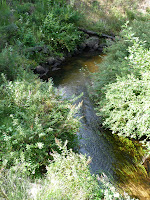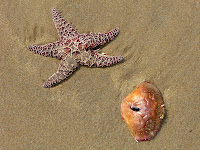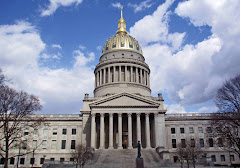The thing that really impressed me then, and impresses me still, about the Simpson Beach area of Shore Acres State Park, however, was/is not the surf. Rather, the thing that impressed me the most was the rocks that I saw there. Now, again, remember, I am no Geologist, and have never even
 had a course in the subject. I know you have sedementary rocks and igneous rocks, one formed by sea sediment, and one formed as a result of volcanic action, but beyond that, I am just a mere tourist(Yes, I know there are more kinds, but I have to go look that up). That said, I was impressed with what I saw. And more importantly, I was impressed with how the rocks I saw left tantalizing suggestions about how things were millions of years ago when the hot lava from the Cascade Volcanoes came down and met the sea, and all the heating cooling and upheaval that occured as a result of this action. And as I walked among the rocks, in most places dwarfed by their size, I simply observed and marveled. No I don't know exactly what happened back then, but whatever it was, it was surely literally "earth-shattering."
had a course in the subject. I know you have sedementary rocks and igneous rocks, one formed by sea sediment, and one formed as a result of volcanic action, but beyond that, I am just a mere tourist(Yes, I know there are more kinds, but I have to go look that up). That said, I was impressed with what I saw. And more importantly, I was impressed with how the rocks I saw left tantalizing suggestions about how things were millions of years ago when the hot lava from the Cascade Volcanoes came down and met the sea, and all the heating cooling and upheaval that occured as a result of this action. And as I walked among the rocks, in most places dwarfed by their size, I simply observed and marveled. No I don't know exactly what happened back then, but whatever it was, it was surely literally "earth-shattering."
There were a few "rocks" that were all scarred, scraped and coated with pocks. These were interesting, but not a new phenomena for me. I had seen similar rocks both at Tobermory ON, and Kelly Island Ohio. So, based upon the presence of these, while I would have liked Simpson Beach, I would not have been as over-awed with it as I became.
No, it wa
 s the combination of the sandstone with lava interspersed that put me" over the top." The sandstone was not the substantial kind such as I see on our place in Greenbrier County WV a lot of the time. Simpson Beach Sandstone was a more fragile sandstone. At one point when I rubbed two of the rocks together very gently, they still crumbled away. Further, they had swirls and strands of color in them that reminded me of a grey-like marble cake. And then into the midst of this marble cake dough-like rock, there was a hard chunk of lava suspended.
s the combination of the sandstone with lava interspersed that put me" over the top." The sandstone was not the substantial kind such as I see on our place in Greenbrier County WV a lot of the time. Simpson Beach Sandstone was a more fragile sandstone. At one point when I rubbed two of the rocks together very gently, they still crumbled away. Further, they had swirls and strands of color in them that reminded me of a grey-like marble cake. And then into the midst of this marble cake dough-like rock, there was a hard chunk of lava suspended.As noted in my last blog, there was a cave at th
 e beach as well. It was a good sized one, as the picture shows. I went over to the entrance, but did not go in. J. far more adventurous than me, did go in. He said the walls of it looked much like the cliffs there at the beach. So how and why did it form? Sure it was from water erosion, I said the sandstone was very crumbly. But why just this cave? Why hadn't the water washed away the rest of the cliffside?
e beach as well. It was a good sized one, as the picture shows. I went over to the entrance, but did not go in. J. far more adventurous than me, did go in. He said the walls of it looked much like the cliffs there at the beach. So how and why did it form? Sure it was from water erosion, I said the sandstone was very crumbly. But why just this cave? Why hadn't the water washed away the rest of the cliffside?Oh yes, one final piece to make this stop on of the highlights of our trip for me. I fo
 und among these amazing rocks Tide Pools. I had mentioned earlier when I was blogging about Cape Perpetua, that I had hoped to see the Tide Pools there, and was disappointed I had arrived at the wrong time in terms of the tides. Well here, I was able to see a few of them.
und among these amazing rocks Tide Pools. I had mentioned earlier when I was blogging about Cape Perpetua, that I had hoped to see the Tide Pools there, and was disappointed I had arrived at the wrong time in terms of the tides. Well here, I was able to see a few of them.In short, this was one amazing place. It was amazing in what it was, and in what it suggested it once had been. Would I return here again if I had the chance? You bet I would!
























































